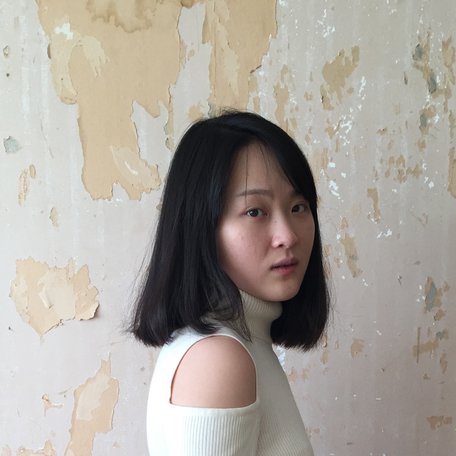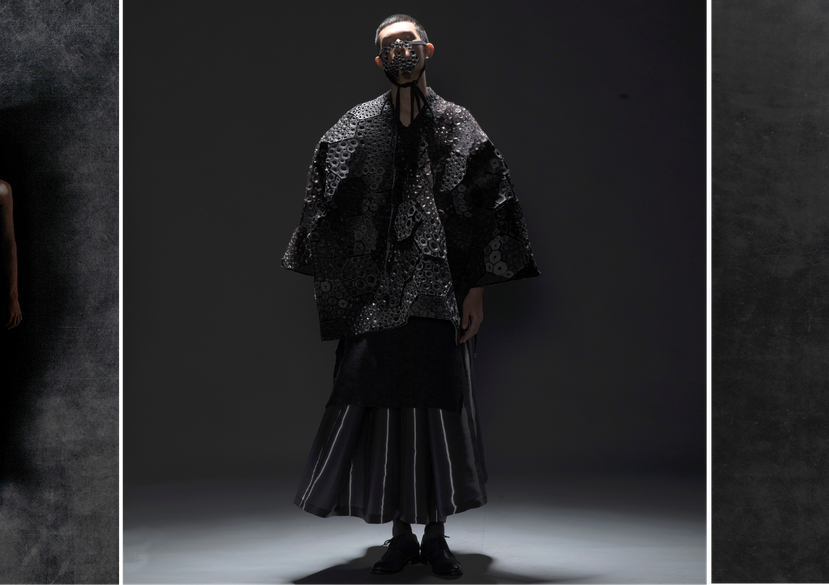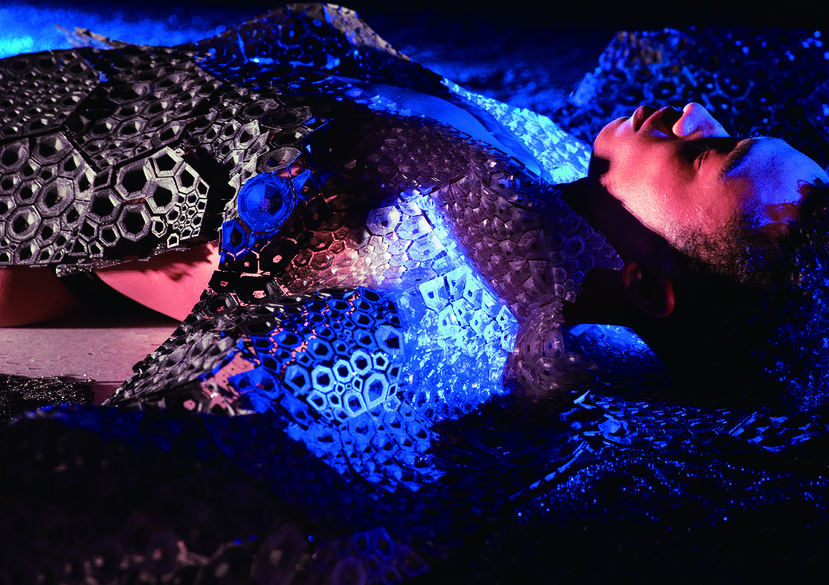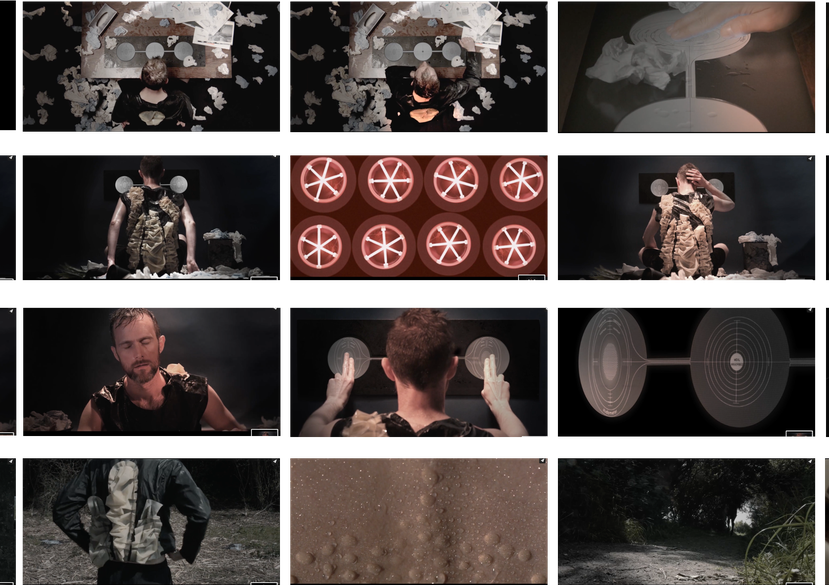
Interfashionality: Body-oriented parametric design and parametric thinking 2.0 for 3D-printed textiles and fashion (completed in 2020)
This practice-based research investigates body-oriented parametric design. It proposes the adaptation of ‘parametric thinking’ (parametric thinking 2.0) to offer new understandings of 3D printing (3DP) for fashion and textile innovations. The adjective parametric is a term used in this research to: 1) digitally express mathematical approaches, such as parametric modelling and parametric tools, which enable a wide range of design options (often similar and relational) to be generated by changing the variables of a computational definition/algorithm; 2) describe a new oppositional, relational way of thinking – parametric thinking, to correlate the independent parameters of a computational setup and the variables of design elements.
With the advancement of 3DP and parametric design, more and more designers’ as well as researchers’ work reflects the growing importance of these emerging digital fabrication and modelling techniques in fashion and textiles development. Considering that developments in the technology of 3DP are primarily driven by materials scientists and engineers, and that parametric design is regularly used for architecture, product design as well as animation, this research asks how fashion and textile designers can contribute our knowledge of working with the human body to designing novel 3D-printed fashion and textile practices.
In my research, the simultaneous considerations of the dynamic body, textile fluidity as well as tactility with existing parametric modelling give rise to a new approach for creating body-oriented 3D-printed textiles and fashion. Here, fashion pattern cutting, textile construction and material performativity are fused with the application of 3DP and parametric software, such as Selective Laser Sintering (SLS), Fused Deposition Modelling (FDM), Stereolithography (SLA), Grasshopper, eVe|Voronax, Processing, Freeform Origami as well as Rigid Origami. The research also delivers a new adaptation of parametric thinking – Parametric Thinking 2.0, derived from parametric design, focusing on raising the awareness of the human body also textile fluidity in the 3D-printed design and design process (Parametric Design 2.0). The notions of ambivalence and Deleuzian ‘becoming’ are used to challenge existing modes of parametric thinking through fashion and textile practices. Together, these approaches advocate body-oriented parametric thinking, which embraces conflicting opposites, such as modernity and tradition, digital technology and craft as well as Eastern and Western design elements, in interdisciplinary and intercultural contexts.
These premises are explored through a phenomenological approach, juxtaposing my experiences with methods that include speculation, theoretical study, communication, collaboration and performance. The research data was collected qualitatively, then categorised into objective or subjective data and expressed through tangible design, text or infographics. Additional analysis was informed by coding, designing, 3D printing, making, displaying and performing a series of 3D-printed textiles for fashion purposes. The cross-boundary collaborations led this research beyond textile and fashion disciplines to the fields of 3DP, architecture and performance. My aspirations are that it will potentially result in new perspectives on fabrication, production and design thinking.
Key details
School, Centre or Area
Supervisors
Personal links
Gallery
More about Mingjing
Biography
Part-time Lecturer in Fashion Technologies at Kingston University
Part-time Lecturer in CLO 3D at University of Portsmouth
Co-founder of L UP L DOWN studio
Co-founder of A-boundary UK-China Creative Community
Degrees
2014–20 PhD in Textiles at Royal College of Art
2012–14 MA in Fashion Design and Technology (Distinction) at London College of Fashion
2008–12 BA in Fashion and Textile Design at Tsinghua University
Experience
Academic Experience
Subject Tutor in Digital Language, Communication and Semiology at Istituto Marangoni
MA Fashion Design Womenswear,MA Luxury Accessory Design Management, MA Fashion Styling, Photography and Film
Visiting Lecturer in Pointcarré Textile Knitting Design (Software) at University of Leeds
BA Textiles Level 1, 2 and 3
Visiting Lecturer in 3D-printed Textiles and Fashion Design at Ensait Textile Engineering University, BA international students
Visiting Lecturer, STEAM for 3D-printed Fashion and Textiles; CLO 3D for Virtual Fashion Design, Pattern Cutting, Rendering and Catwalk, at Tsinghua University
BA and MA Fashion Design
R&D and Industrial Experience
Wearable Consultant for Vigor Innotech, London (2016)
Wearable Consultant for EU-award-winning Wisp Tech, London (2017)
Design assistant at H&M Stockholm Headquarter (2015)
Catwalk Organizer and Design Assistant at PINGHE studio (2013)
Awards
August 2019, nominated as ‘Top 100 Women in Fashion Tech’ by Women of Wearable Technology (WOW)
October 2018, Barcelona
Fold-the-Interfashionality project won the 2nd prize of the competition Reshape18 by Noumena, IN(3d)USTRY – From Needs to Solutions and Fira de Barcelona (Barcelona exhibition center).
March 2015, London
IFF International Perfume competition shortlist
April 2014
ITS - International Talent Support Competition
September 2018, Birmingham
Shortlist-TCT 3D Printing Creative Application Award Finalist
17 May 2018, London
Fold-the-Interfashionality project was nominated as ‘Best Design and Art Creation of the Year’ by 3D Printing Award
April 2012, Excellent Fur and Leather Design Awards by Copenhagen fur Co., Ltd.
Funding
EU Commission Horizon 2020 WearSustain
Project Wisp Sustainable and Digital Jewellery
Position: (Co-applicator) Fashion and Textile Wearable Consultant, August 2017- March 2018, 50 000€.
Research project Inter-fashionality
(Main Investigator)
The funding was provided by Beijing Fashion Institution and BMW (Bayerische Motoren Werke) Intangible Cultural Heritage Protection Innovation Center at the Tsinghua Unversity, 15 000€
Research project Fold-the-Interfashionality
(Main Investigator)
The funding was provided by Sinterit 3D printing company and it covers all the costs of 3D printing and international shipping
Exhibitions
28 November 2017 – 3 December 2018, London
Solo performance and exhibition Fold-the-Interfashionality: 3D-printed Costume for Beijing Opera at Royal College of Art
11–16 October 2016, Royal College of Art, London
Inter-fashionality: 3D printed Qipao solo exhibition and fashion performance at Royal College of Art
21–23 September 2018, London Design Festival, London
Burberry Material Futures Research Group and the Intelligent Mobility Design Centre
9 March 2018, London
E-stitches at the V&A (Victoria and Albert Museum)
November 2019, National Museum of China and Tsinghua University
The 5th Arts and Science International Exhibition and Symposium (AS-Helix: The Integration of Art and Science in the Age of Artificial Intelligence)
7 February 2018, Barcelona (Spain)
'What’s Next-Material that will shape the future’ exhibition at Disseny de Barcelona
3 February 2018, Hangzhou (China)
Neo Haute Couture for 3D Tech-fashion at China Silk Museum
27 September 2017, Beijing
T100 catwalk at Beijing Fashion Week
June 2017, Beijing
Jinxiu China: Intangible Cultural Heritage Catwalk of Chinese Fashion at Prince Gong Mansion
April 2017, Beijing
International Defending Dyeing Art Exhibition -Inheritance & Innovation at Art & Science Research Centre of Tsinghua
Publications
Lin, M. (2020). Inter-Fashionality: Body-oriented Parametric Design and Parametric Thinking 2.0 for 3D-Printed Textiles and Fashion. Ph.D thesis. Royal College of Art. Available at: https://researchonline.rca.ac.uk/4527/
Lin, M. and Huang, T. (2019) Digital Crafting through Pleating, 3D Printing and Performing (in Pending). Bloomsbury Encyclopedia of World Textiles. 10(1).
Lin, M. and Huang, T. (2019). Fold-the-Interfashionality: A Dialogue between Modernity and Tradition in the Era of AI. In: AS-Helix: The Integration of Art and Science in the Age of Artificial Intelligence. Works Collection of the 5th Art and Science International Exhibition. Beijing: Tsinghua University, pp. 108-109.
Lin, M. and Li, Y. (2019). Inter-fashionality. In: AS-Helix: The Integration of Art and Science in the Age of Artificial Intelligence. Works Collection of the 5th Art and Science International Exhibition. Beijing: Tsinghua University, pp. 118-119.
Lin, M. (2017). 3D Printed Dress towards the Ambivalence in Fashion Design. In: Culture, Costume and Dress. [online] Birmingham: Birmingham City University, pp. 11-12. Available at: https://play.google.com/books/reader?id=RyRLDwAAQBAJ&pg=GBS.PR1 [Accessed 26 Nov. 2018].
Lin, M. (2017). Inter-fashionality. In: Smart Textile Salon. [online] Ghent: Department of Textiles Ghent University, pp.58-59. Available at: https://issuu.com/ugent.textiles/docs/sts2017_booklet_final.
Lin. M. (2017). The New Parameters of 3D-printed Textile for Fashion Design. In: The Association of Fashion and Textile Courses. [online] http://www.ftc-online.org.uk/wp-content/uploads/2017/05/Mingjing-Lin.pdf
Conferences
16–18 October 2017, Ghent (Belgium)
ITMC (International Conference on Intelligent Textiles and Mass Production) and Smart Textile Salon.
May 2017, Birmingham City University, Birmingham (UK), Culture Costume and Dress Conference & Exhibition
14–17 November 2017, Frankfurt (German), Formnext 17: International Exhibition and Conference on the Next Generation of Manufacturing Technologies
November 2019, National Museum of China and Tsinghua University, The 5th Arts and Science International Exhibition and Symposium (AS-Helix: The Integration of Art and Science in the Age of Artificial Intelligence)
14–23 November 2014, Beijing, The Tao of Sustainability-An International Conference and Exhibition on Sustainable Design at Tsinghua University



